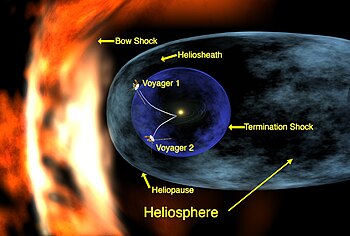| Revision as of 01:26, 8 April 2007 editThe Letter J (talk | contribs)Extended confirmed users1,147 editsNo edit summary← Previous edit | Revision as of 11:14, 11 April 2007 edit undo69.247.164.232 (talk) Really... wiki is accurate, yes, but shouldn't be complex for the sake of being complex.Next edit → | ||
| Line 5: | Line 5: | ||
| The shock arises because solar wind particles are emitted from stars at about 400 km/s, while the speed of sound (in air) is about 0.33 km/s. (The exact speed depends on the density, which fluctuates considerably.) The interstellar medium, although very low in density, nonetheless has a constant pressure associated with it; the pressure from the solar wind decreases with the square of the distance from the star. As one moves far enough away from the star, the pressure from the interstellar medium becomes sufficient to slow the solar wind down to below its speed of sound; this causes a ]. | The shock arises because solar wind particles are emitted from stars at about 400 km/s, while the speed of sound (in air) is about 0.33 km/s. (The exact speed depends on the density, which fluctuates considerably.) The interstellar medium, although very low in density, nonetheless has a constant pressure associated with it; the pressure from the solar wind decreases with the square of the distance from the star. As one moves far enough away from the star, the pressure from the interstellar medium becomes sufficient to slow the solar wind down to below its speed of sound; this causes a ]. | ||
| ] | ] | ||
| Other termination shocks can be seen in terrestrial systems; perhaps the easiest may be seen by simply running a ] ] into a ]. Upon hitting the floor of the sink, the flowing water spreads out at a speed that is higher than the local ], forming a disk of shallow, rapidly diverging flow (analogous to the tenuous, supersonic solar wind). Around the periphery of the disk, a shock front or wall of water forms; outside the shock front, the water moves slower than the local wave speed (analogous to the subsonic interstellar medium). | Other termination shocks can be seen in terrestrial systems; perhaps the easiest may be seen by simply running a ] ] into a ]. Upon hitting the floor of the sink, the flowing water spreads out at a speed that is higher than the local ], forming a disk of shallow, rapidly diverging flow (analogous to the tenuous, supersonic solar wind). Around the periphery of the disk, a shock front or wall of water forms; outside the shock front, the water moves slower than the local wave speed (analogous to the subsonic interstellar medium). | ||
Revision as of 11:14, 11 April 2007

In space physics, the termination shock is the boundary marking one of the outer limits of the sun's influence. It is where the bubble of solar wind particles slows down to subsonic speed (with respect to the star) due to interactions with the local interstellar medium. This causes compression, heating, and a change in the magnetic field. The termination shock is believed to be 75-90 astronomical units from the Sun. The termination shock boundary fluctuates in its distance from the sun as a result of fluctuations in solar flare activity, i.e. changes in the ejections of gas and dust from the sun.
The shock arises because solar wind particles are emitted from stars at about 400 km/s, while the speed of sound (in air) is about 0.33 km/s. (The exact speed depends on the density, which fluctuates considerably.) The interstellar medium, although very low in density, nonetheless has a constant pressure associated with it; the pressure from the solar wind decreases with the square of the distance from the star. As one moves far enough away from the star, the pressure from the interstellar medium becomes sufficient to slow the solar wind down to below its speed of sound; this causes a shock wave.

Other termination shocks can be seen in terrestrial systems; perhaps the easiest may be seen by simply running a water tap into a sink. Upon hitting the floor of the sink, the flowing water spreads out at a speed that is higher than the local wave speed, forming a disk of shallow, rapidly diverging flow (analogous to the tenuous, supersonic solar wind). Around the periphery of the disk, a shock front or wall of water forms; outside the shock front, the water moves slower than the local wave speed (analogous to the subsonic interstellar medium).
Going outward from the sun, the termination shock is followed by the Heliopause where solar wind particles are stopped by the interstellar medium, then the bow shock past which particles from the interstellar medium are no longer excited.
Evidence presented at a meeting of the American Geophysical Union in May 2005 by Dr. Ed Stone suggests that the Voyager 1 spacecraft passed termination shock in December 2004, when it was about 94 AU from the sun, by virtue of the change in magnetic readings taken from the craft. In contrast, Voyager 2 began detecting returning particles when it was only 76 AU from the sun, in May 2006. This implies that the heliosphere may be irregularly shaped, bulging outwards in the sun's northern hemisphere and pushed inward in the south..
The Interstellar Boundary Explorer (IBEX) mission will attempt to gather more data on the solar system's termination shock.
See also
External links
- Technical comments on termination shocks
- Paper on the Heliosphere including comments on termination shock
- The Heliospheric Termination Shock Structure